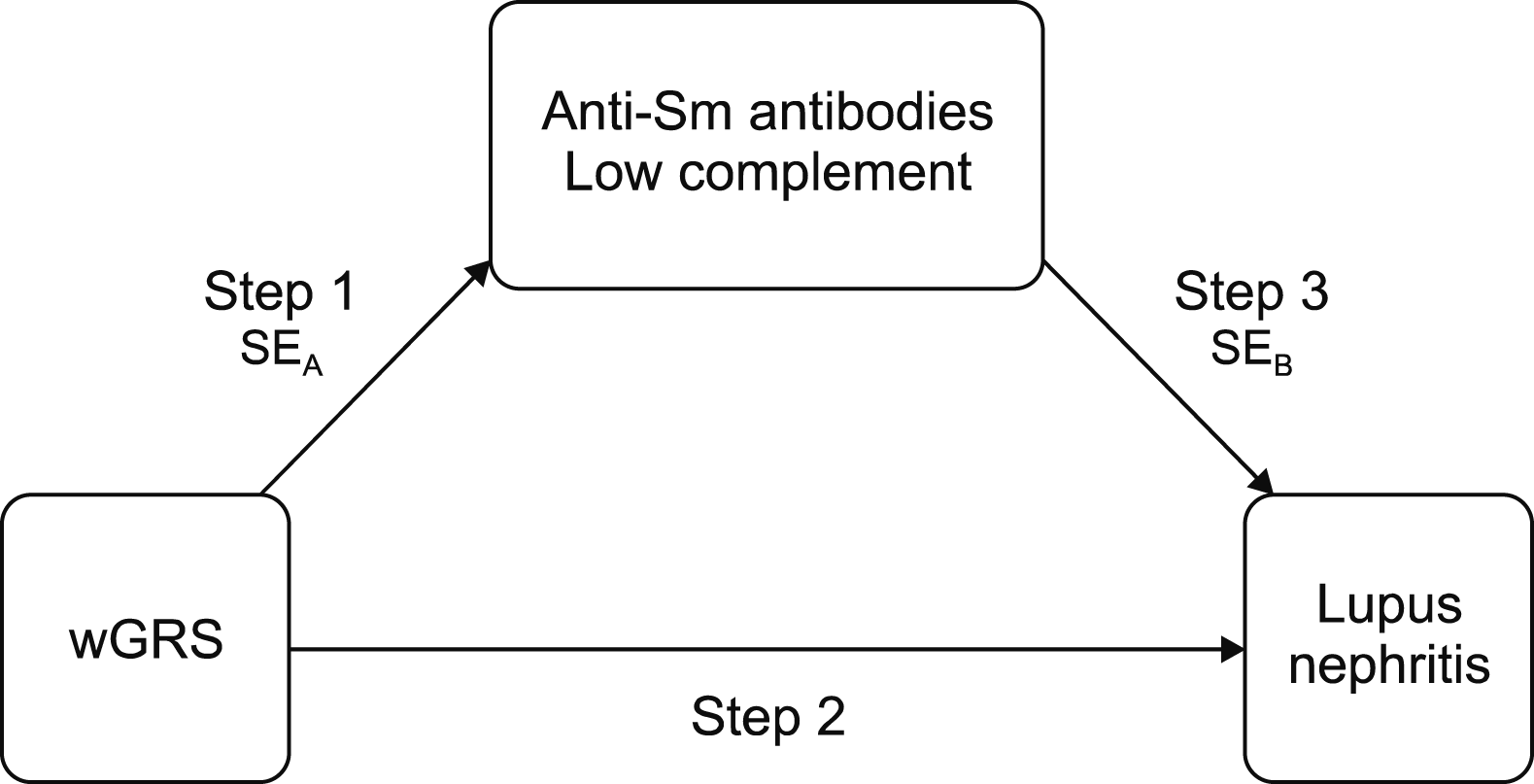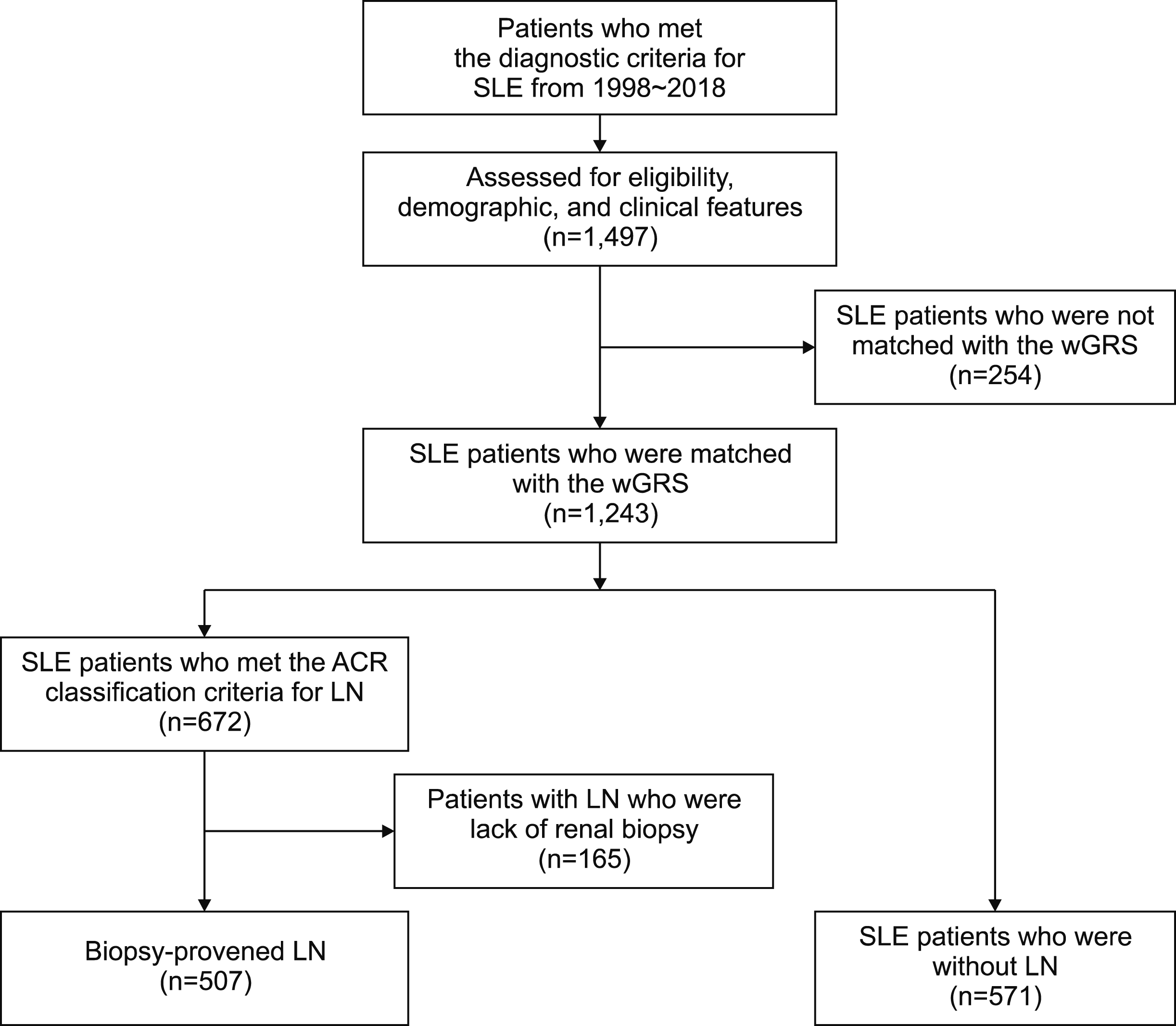INTRODUCTION
MATERIALS AND METHODS
Patients
Clinical characteristics
Calculation of the wGRS
Statistical analyses
 | Figure 2Conceptual model on three-step relationship between the exposure, mediator, and outcome. Step 1: association between the wGRS and serologic markers calculated by logistic regression analysis, step 2: association between the wGRS and lupus nephritis (LN) calculated by logistic regression analysis, step 3: association between serologic markers and LN calculated by logistic regression analysis, Sm: Smith, SEA: associated standard error for step 1 calculated by Sobel’s test, SEB: associated SE for step 3 calculated by Sobel’s test, SEA for anti-Sm antibodies: 0.066, SEA for low complement: 0.057, SEB for anti-Sm antibodies: 0.157, SEB for low complement: 0.141. |
RESULTS
Differences in demographics and clinical manifestations
Table 1
| Variable |
All patients (n=1,078) |
LN (n=507) |
Non-LN (n=571) |
p-value |
|---|---|---|---|---|
| Sex, female | 995 (92.3) | 457 (90.1) | 538 (94.2) | 0.017 |
| Age at diagnosis of SLE (yr) | 28.0±10.8 | 25.4±10.2 | 29.4±11 | <0.001* |
| Duration between SLE diagnosis and enrollment (yr) | 2.8±3.7 | 3.2±4.1 | 2.4±3.4 | <0.001* |
| wGRS | 22.8±1.2 | 22.9±1.1 | 22.6±1.2 | <0.001* |
| Malar rash | 467 (43.4) | 247 (48.7) | 220 (38.6) | 0.001 |
| Discoid rash | 84 (7.8) | 33 (6.5) | 51 (8.9) | 0.172 |
| Photosensitivity | 370 (34.5) | 164 (32.4) | 206 (36.3) | 0.288 |
| Oral ulcer | 372 (34.5) | 166 (32.8) | 206 (36.1) | 0.196 |
| Arthritis | 698 (64.8) | 324 (63.9) | 374 (65.6) | 0.602 |
| Serositis | 244 (22.7) | 160 (31.6) | 84 (14.7) | <0.001 |
| Pleuritis | 185 (17.2) | 127 (25.1) | 58 (10.2) | <0.001 |
| Pericarditis | 145 (13.5) | 96 (19.0) | 49 (9.0) | <0.001 |
| Neurologic disorder | 48 (4.5) | 24 (4.7) | 24 (4.2) | 0.768 |
| Immunologic disorder | 934 (86.8) | 466 (92.0) | 468 (82.3) | <0.001 |
| Anti-dsDNA antibodies | 838 (77.8) | 436 (86.0) | 402 (70.6) | <0.001 |
| Anti-Sm antibodies | 207 (19.2) | 124 (24.5) | 83 (14.6) | <0.001 |
| Low complement | 791 (73.4) | 399 (78.7) | 392 (68.7) | <0.001 |
| aPL antibodies | 321 (30.0) | 133 (26.2) | 188 (33.0) | 0.018 |
| Hematologic disorder | 885 (82.3) | 428 (84.6) | 457 (80.2) | 0.070 |
| Hemolytic anemia | 163 (15.1) | 89 (17.6) | 74 (13.0) | 0.045 |
| Leukopenia | 638 (59.3) | 301 (59.5) | 337 (59.1) | 0.953 |
| Lymphopenia | 686 (63.8) | 341 (67.4) | 345 (60.5) | 0.023 |
| Thrombocytopenia | 259 (24.0) | 139 (27.4) | 120 (21.0) | 0.017 |
| ANA | 1,078 (100) | 507 (100) | 571 (100) | - |
| Total number of ACR criteria | 5.2±1.4 | 5.8±1.4 | 4.7±1.2 | <0.001* |
| SDI | 0.3±0.7 | 0.4±0.9 | 0.3±0.6 | 0.001* |
| SDI, non-renal | 0.3±0.6 | 0.3±0.7 | 0.3±0.6 | 0.437* |
| Renal biopsy classification | ||||
| II+V | 2 (0.4) | |||
| III | 106 (20.9) | |||
| III+V | 68 (13.4) | |||
| IV | 226 (44.6) | |||
| IV+V | 30 (5.9) | |||
| V | 75 (14.8) | |||
| Activity index, n=312† | 7.0±4.2 | |||
| Chronicity index, n=312† | 1.7±1.6 |
Values are presented as mean±standard deviation, or number (%). LN: systemic lupus erythematosus patients with lupus nephritis, non-LN: systemic lupus erythematosus patients without LN, SLE: systemic lupus erythematosus, wGRS: weighted genetic risk score, dsDNA: double-stranded deoxyribonucleic acid, Sm: Smith, aPL: antiphospholipid, ANA: antinuclear antibodies, ACR: American College of Rheumatology, SDI: Systemic Lupus International Collaborating Clinics/ACR Damage Index total score at enrollment, SDI, non-renal: total score of SDI at enrollment except for the variables related to LN; such as proteinuria, pyuria, hematuria, and abnormal urinary casts. *p-values are calculated by Student’s t-test and the chi-square test. p-values<0.05. †Numbers are reduced due to lack of data.
Factors associated with the presence of LN
Table 2
| Variable | Univariate analysis | Multivariate analysis | |||||
|---|---|---|---|---|---|---|---|
| OR | 95% CI | p-value | OR* | 95% CI | p-value | ||
| Age at diagnosis of SLE (yr) | 0.97 | 0.95∼0.98 | <0.001 | 0.97 | 0.96∼0.99 | <0.001 | |
| Male sex | 1.78 | 1.12∼2.82 | 0.013 | 1.51 | 0.91∼2.50 | 0.112 | |
| Duration between SLE diagnosis and enrollment (yr) | 1.06 | 1.03∼1.10 | <0.001 | 1.04 | 1.01∼1.08 | 0.024 | |
| wGRS | 1.24 | 1.12∼1.38 | <0.001 | 1.16 | 1.01∼1.08 | 0.012 | |
| Malar rash | 1.51 | 1.19∼1.93 | <0.001 | 1.08 | 0.81∼1.43 | 0.581 | |
| Pleuritis | 2.95 | 2.10∼4.14 | <0.001 | 2.44 | 1.65∼3.60 | <0.001 | |
| Pericarditis | 2.49 | 1.72∼3.60 | <0.001 | 1.62 | 1.05∼2.50 | 0.029 | |
| Hemolytic anemia | 1.43 | 1.02∼2.00 | 0.037 | 1.17 | 0.80∼1.70 | 0.425 | |
| Lymphopenia | 1.35 | 1.05∼1.73 | 0.020 | 1.23 | 0.94∼1.62 | 0.132 | |
| Thrombocytopenia | 1.42 | 1.07∼1.88 | 0.014 | 1.28 | 0.94∼1.74 | 0.125 | |
| Anti-dsDNA antibodies | 2.57 | 1.93∼3.51 | <0.001 | 2.22 | 1.59∼3.10 | <0.001 | |
| Anti-Sm antibodies | 1.90 | 1.40∼2.59 | <0.001 | 1.70 | 1.21∼2.38 | 0.002 | |
| Low complement | 1.69 | 1.28∼2.22 | <0.001 | 1.37 | 1.01∼1.86 | 0.043 | |
| Negative aPL antibodies | 1.39 | 1.07∼1.81 | 0.015 | 1.60 | 1.19∼2.13 | 0.002 | |
| Negative anti-β2 GPI IgM antibodies | 2.98 | 1.58∼5.21 | <0.001 | ||||
| Negative anti-cardiolipin antibodies | 1.47 | 1.08∼2.00 | 0.014 | ||||
| Negative lupus anticoagulant | 1.61 | 1.11∼2.34 | 0.012 | ||||
OR: odds ratio, OR*adjusted for age at diagnosis, sex, and the duration between SLE diagnosis and enrollment, CI: confidence interval, SLE: systemic lupus erythematosus, wGRS: weighted genetic risk score, dsDNA: double-stranded deoxyribonucleic acid, Sm: Smith, aPL: antiphospholipid. p-values and OR are calculated by logistic regression analyses. p-values<0.05.
Relationships among the wGRS, serology, and the presence of LN
Table 3
OR: odds ratio, CI: confidence interval, wGRS: weighted genetic risk score, Sm: Smith, Step 1: association between the wGRS and serologic markers, Step 2: association between serologic markers and lupus nephritis, Step 3: association between the wGRS and lupus nephritis. p-values and OR are calculated by logistic regression analyses. p-values<0.05.




 PDF
PDF Citation
Citation Print
Print




 XML Download
XML Download